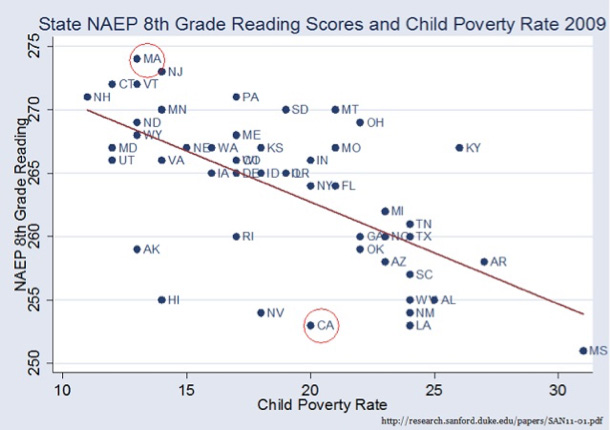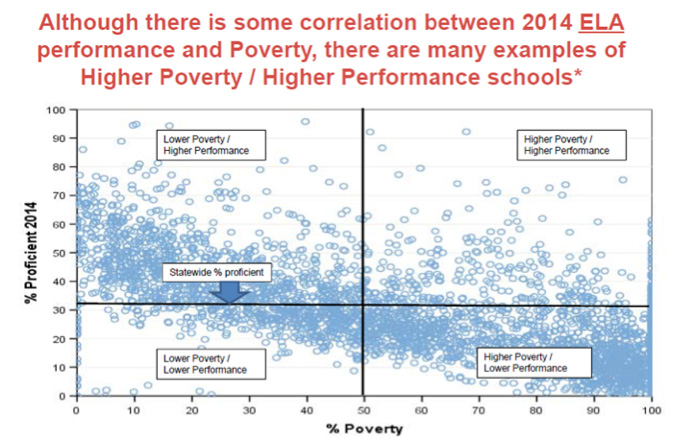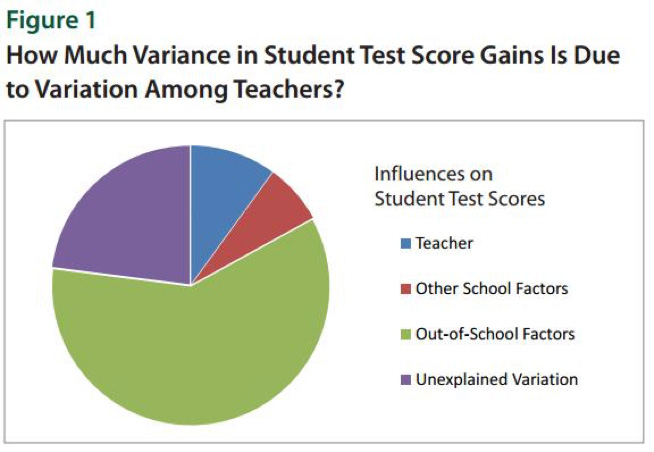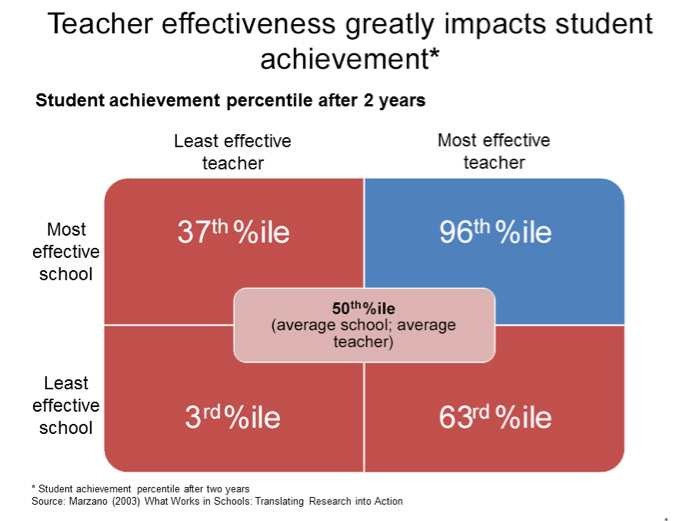Contents
Required Reading
- Michelle Rhee, Joel Klein and various school superintendents. Rhee and Klein, former chancellors of the Washington, D.C. and New York City public school districts, respectively, released a 2010 Manifesto outlining how to fix schools by championing a “no excuses” mindset (i.e. avoiding blaming poverty-related factors for poor student performance) and focusing on teacher quality as the single most important factor determining student success.
- Paul E. Peterson. (2012). Neither Broad Nor Bold: A Narrow-Minded Approach to School Reform. Critiquing the APPAM Presidential address by Helen Ladd that was featured in last month’s MOOC, Peterson vigorously challenges the premises and policies of the Broader, Bolder Approach to Education by disputing the asserted links between social and economic disadvantage and low student achievement. Citing research identifying other factors, including parents’ education, family structure, and effective teachers, as more significantly influencing student achievement, he dismisses the premise that “poverty and income inequality, not inadequate schools, are the fundamental problem in American education that needs to be fixed,” and instead advances test-based accountability, school choice, and teacher policy reforms (e.g. merit pay incentives, elimination of tenure).
- Edward H. Haertel. March 22, 2013 William H. Angoff Memorial lecture at the National Press Club. Reliability and Validity of Inferences about Teachers Based on Student Test Scores. Education Testing Service. Haertel, a researcher at Stanford University, examines the use of value-added models (VAMs) to measure teacher effectiveness. Complex and controversial statistical models for calculating teacher value-added estimates, VAMs have shaped efforts over the past decade to use teacher evaluation systems to guide promotion, support and firing decisions, seen as critical in the “no excuses” school reform movement. Haertel begins by assessing how much differences in teacher quality (versus other factors) affect student achievement, and cites their relatively small contribution – and thus the need to distinguish them from statistical “noise” – as one of many problems with this use of VAMs.
- Equity and Excellence Commission. (2013). For Each and Every Child: A Strategy for Education Equity and Excellence.S. Department of Education. Convened by Education Secretary Arne Duncan, the Commission starkly documents large and persistent inequities that impede progress in the U.S. education system. The report offers five major sets of recommendations in the categories of: equitable funding and resources, effective teaching and leadership, access to high quality curriculum and learning opportunities, access to quality early childhood education and out-of-school time enrichment, and addressing poverty-driven issues of student health and nutrition.
- Anthony S. Bryk. (2009). Organizing Schools for Improvement: Lessons from Chicago. The University of Chicago Press. Bryk’s seminal book on effective school improvement models, which rely on integrated ecosystems of non-school and school-based factors, illustrates the problem with arguments like those above that fail to see how factors interact and instead try to point to specific factors as determinative. In the second chapter, they identify a comprehensive set of practices and conditions that are essential to improving educational outcomes. Considering these as five “ingredients” akin to cake-baking (i.e., if any is too little or left out, the cake doesn’t come out right), they cite: school leadership, parent-community ties to school, including social and economic conditions, the professional capacity of the faculty and staff, a student-centered learning climate, and instructional guidance. .
Optional Reading List
- In 2009, the New Teacher Project, founded to address the inequitable distribution of effective teachers, published The Widget Effect: Our National Failure to Acknowledge and Act Upon Teacher Effectiveness. The report, which surveyed teacher evaluation and dismissal over 15,000 teachers and 1,300 principals in 12 school districts, concluded that the U.S. public education system treats teachers as “interchangeable parts, rather than individual professionals.” It argued that teacher evaluation was seriously flawed, rating most teachers as good or great. While generally well received, the report did not consider prior research (e.g. Ray Pecheone) on why evaluation systems don’t work: they rely on administrators who have inadequate time, pedagogical expertise, tools, and processes and have a limited understanding of effective teaching.
- Critics of this report note that it is likely that most teachers actually are either good or great – but that the main purpose of an evaluation and accountability system should be to help all, but especially the majority in the middle, to improve. The Peer Assistance and Review Program (see this discussion in Education Week) that was developed in Toledo, Ohio, and has since been adopted in Montgomery County, Maryland, San Juan, California, Minneapolis, Minnesota, and other school districts has been found by a rigorous review out of Harvard – A User’s Guide to PAR – to do exactly that, both effectively and cost efficiently. The PAR program succeeds by creating a collegial culture in which teachers and principals use a variety of sources for ongoing feedback to reflect on teaching and learning and thereby build a process of continuous improvement.
- Big Study Links Good Teachers to Lasting Gains. January 6, 2012. This New York Times article discusses the work of Raj Chetty and his colleagues, which shows that teachers can have wide-ranging and lasting positive effect on student lives. An advocate of using VAM in teacher evaluation, Chetty finds students can learn in any given year somewhere between 10 and 20 percent of a standard deviation more if they have an effective teacher rather than a very ineffective one. He also estimates that replacing a teacher in the bottom 5% VAM by an average one (which is the equivalent of a full standard deviation improvement) would increase the lifetime earnings of that teacher’s entire class by more than $250,000. While highly technical, see Chetty’s study, The Long-Term Impacts of Teachers: Teacher Value-Added and Student Outcomes in Adulthood
- Civil Rights and Testing: Response to Haycock and Edelman, June 10, 2015, and Annual Accountability Testing: Time for the Civil Rights Community to Reconsider, May 28, 2015. In these two Ed Week Blogs, Marc Tucker, Executive Director of the National Center on Education and the Economy, responds to criticisms from Kati Haycock, Jonah Edelman and others who challenge his argument that policy changes based on annual testing and accountability have not helped students of color and have, in fact, done some damage to schools serving them. Some charged that his call for the Civil Rights community to reconsider their support for this reform is an attack on their leadership and endangers their unified consensus, which is needed to ensure needed public engagement and equity in testing and accountability.
Graphics & Data

As the graph above shows, there is a there is a strong negative correlation (-0.71) between a state’s child poverty rate and how proficient 4th graders read in each state. In general, the lower a state’s child poverty rate the better its students score on reading proficiency tests. Data are from the 2009-10 school year.

This chart is based on New York state students in grades 3-8 in the 2013-14 school year. Overall, there is a strong correlation between achievement and poverty. There are, however, exceptions to this pattern that invite further investigation. They may perhaps illustrate strategies to mitigate the effects of poverty (rather than reduce it) that can have a positive impact on student outcomes.

This pie chart, based on research by Edward Haertel, illustrates the many factors beyond single teachers that influence student achievement. These other factors include other in- school factors such as class size, curriculum, instructional time, availability of specialists and tutors, and resources for learning (books, computers, science labs, and more); and, a much larger share, non-school factors such as home and community supports or challenges, and individual student needs and abilities, health, and attendance.

Studies like this one by Robert Marzano support the premise that teacher effectiveness can greatly impact student achievement. If an average student in an average school has an effective teacher two years in a row, then this student can achieve the 96% percentile of performance. Marzano uses a complex rubric according to research-based elements for both effective teachers and effective schools, respectively, and this chart measures the impacts of those effective schools and effective teachers according to that specific rubric. In addition to questions about this versus the BBA and other perspectives, another is how, in practice, to create such effective schools and recruit and retain the best teachers.
Video
“Getting Better at Getting Better,” at the NEA Foundation’s October 9, 2015 Cross-Site Convening, featuring: Tony Bryk, President, Carnegie Foundation for the Advancement of Teaching. Bryk discusses how multiple individuals and stakeholders in a variety of roles in a school community can and must come together with shared purpose in a coherent and unified way for effective school reform. He decries the fragmentation and “initiative fatigue” that characterize education reform in general and suggests the current chasm between heightened aspirations in reform and what we actually achieve for poor and low-income students is the “greatest social justice issue of our time.”In response, he presents his “school improvement paradigm” centered on six big ideas, based on his successful work in some of Chicago’s most disadvantaged schools.
Book Club Recommendation
If a MOOC session is not your thing, try suggesting this for your next book club instead. These follow the same theme as the more scholarly articles listed above, but make for good discussion over crackers, cheese, and wine.
- Ravitch, Diane. (2013). Reign of Error: The Hoax of the Privatization Movement and the Danger to America’s Public Schools, Knopf. See especially chapter 10, “How Poverty Affects Academic Achievement,” starting at p.91. Ravitch is one of the foremost critics of the standards-based reform movement and particularly, since No Child Left Behind and the dominance of the “no excuses” school reform movement, it’s over reliance on high stakes testing and accountability. Having herself been one of the strongest advocates for the testing-and-accountability agenda, she combines the passion of a new convert with the deep wisdom of one of the leading historians of U.S. education. But does she go too far in suggesting that all is well with U.S. schools, and in providing plenty of critique but less in the way of fixes?
Study Questions
Question #1
Rhee, Klein, Chetty, and Thernstrom rightly argue that schools and teachers can make a critical difference in the lives of children; Thernstrom suggests that school-based factors explain up to two-thirds of the variation in achievement among student of color and poor and low-income students. Is this “no excuses” argument tenable in light of decades of evidence of larger impacts of out-of-school factors and more recent research by Reardon that not only finds the correlation between achievement and socioeconomic status increasing over the past decade but also attributes much of this increase to academic enrichment outside of school provided by more affluent parents?
Question #2
Why do you think this argument over the primary cause of the achievement gap, expressed generally as due to either ineffective teachers and leaders or family, social and economic disparities, has become so heated and polarizing in politics and culture in the U.S. since the passage of No Child Left Behind, which originally represented a bipartisan consensus in Congress and across the nation’s governors?
Question #3
Both Bryk and colleagues’ work in Chicago and the Equity and Excellence Commission offer a way out of the false “either/or” debate above over how to close the achievement gap by finding that both in-school and out-of-school factors play significant roles (and interact). How are the Commission’s recommendations, which correspond to the Broader, Bolder Approach to Education, reflected in the recent reauthorization of the Elementary and Secondary Education Act called the Every Student Succeeds Act (ESSA)? Where does the legislation fall short?